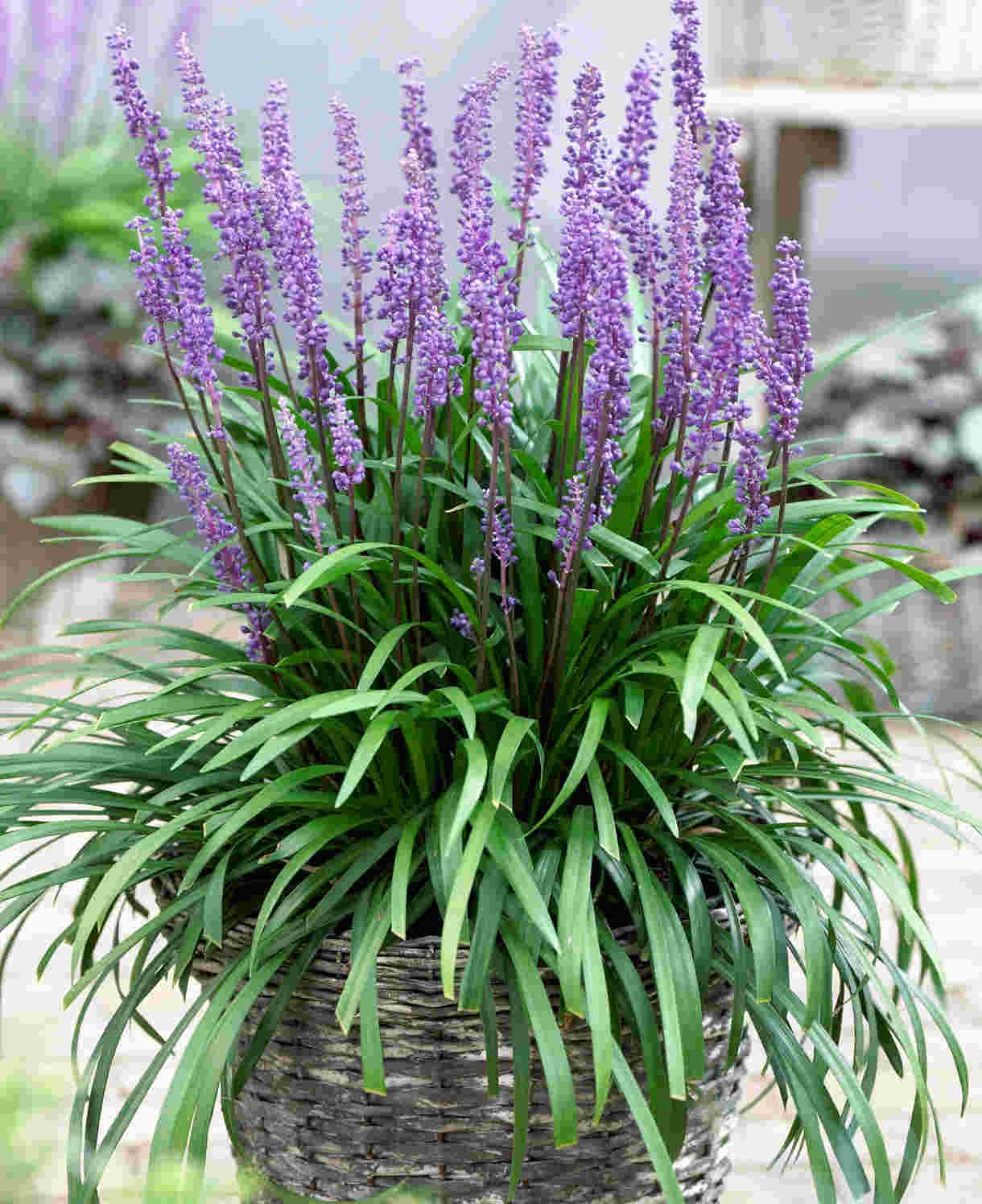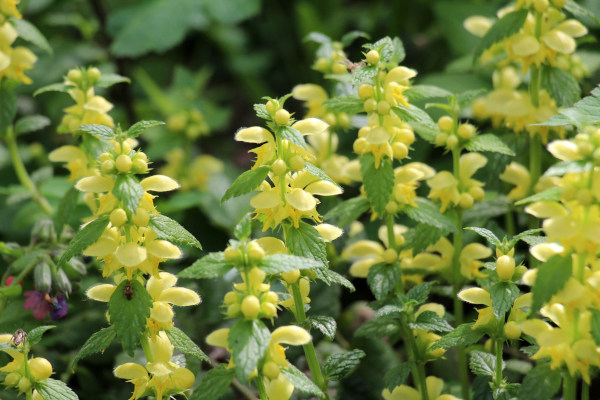How to grow Lamium
Also known as dead-nettle, lamium is a genus of around 50 species of annual and perennial plants found throughout Europe, Asia, and North Africa. As a member of the mint family, its relatives include sage, rosemary, and nepeta, though appearance-wise it bears a strong resemblance to the stinging nettle (Urtica dioica). Though superficially similar two are not closely related and lamium does not bear stinging hairs. It produces whorls of double-lipped, mint-like flowers, usually from late spring to summer which, as is the case with most members of the mint family, are highly attractive to a range of pollinators.
There are several wild lamium species native to the UK, though the species popular in gardens have been introduced from elsewhere. Probably the most widely grown is Lamium maculatum from Lebanon, Syria, Turkey, and China. There are many cultivated forms of this, though the most popular such as ‘Beacon Silver’, ‘Shell Pink’, ‘Anne Greenaway’ and ‘White Nancy’, tend to offer variegated foliage. L. orvala is another favourite, originating from south central Europe. Unlike L. maculatum which spreads enthusiastically by underground rhizomes, L. orvala is a non-invasive, clump forming species.
Lamium is an easy-to-grow plant which needs little care once established. It is best known as a shade-lover, though there are a few lesser-known species that prefer sun (L. armenum and L. garganicum).

Zantedeschia is a genus of flowering plants from the family Araceae and is native to southern Africa. With a rich history dating back to the Ancient Romans, these deciduous or semi-evergreen perennials have been used as a symbol of celebration. Zantedeschia was Named after Professor Giovanni Zantedeschia, an Italian botanist.
There are two main forms of Zantedeschia: hardy and tender. Hardy forms of the plant can be grown outdoors, enjoy moist soil and full sun or partially shaded conditions - these are known as Arum lilies. Tender forms of Zantedeschia prefer being grown in containers or pots and should be brought inside over the winter - these are known as Calla lilies.
With tuberous flora in all colours from whites, yellows and oranges to deep reds and purples, Zantedeschias are not to be overlooked in any garden, as long as they have sufficient sunlight to grow in.
Ready to learn more about growing Zantedeschia? Read on for all there is to know...

Key Information
Soil pH
Position
Hardiness


Where & when to plant Lamium
Position - Usually partial to deep shade
Soil - Tolerant of a range of soils. Avoid the extremes of waterlogged or very dry.
Flowering Period - Usually late spring to summer.
Hardiness - Fully hardy, usually rated H7 (-20°C and beyond)
For best results, plant in autumn or spring. An autumn planting can be done by those gardening in mild conditions (and broadly speaking, this is the southern half of the UK). For those liable to cold winters, it is best to wait until spring (generally the northern half of the UK). Planting can also be carried out in summer, though be prepared to water regularly.
Vigorous, ground-covering species such as L. maculatum and its cultivars are useful for planting beneath trees and shrubs or edging a shady path. They are likely to be rampant in moist, fertile soil and more restrained in poorer conditions, so space apart from other plants accordingly. Clump-forming species such as L. orvala can be woven throughout shady borders or grown in a container.
How to plant Lamium
· For planting in the garden, dig the soil area removing any large stones and weeds and breaking up any lumps. Mix in some organic matter such as manure or garden compost. Rake level and firm with your heels. Rake level again.
· Water plant well and allow to drain before planting.
· Dig a hole twice the size of the root-ball.
· Place the plant in the hole, ensuring the top of the root ball sits level with the surface of the soil. Too low and the plant may rot, too high and the roots can dry out.
· Backfill with soil and firm in gently with your foot.
· Soak well with water.
· Mulch around the base with well-rotted organic matter.
· For planting in a container, find a pot a few centimetres larger than the rootball, ensuring there are plenty of drainage holes.
· If you are using a heavy pot, it can be a good idea to fill and plant it in situ to save yourself the trouble of moving once full.
· Use a good quality potting compost with plenty of horticultural grit mixed in, and, if not already present in the compost (check the description on the bag) some slow-release fertiliser granules.
· Start by partially filling the pot with compost; enough so that when placed on it the upper surface of the root ball is about 3cm lower than the top of the pot.
· Infill all the space surrounding the root ball with compost, firming down with your fingers then adding a little more so the plant is held tight.
· Pick up the container and lightly tap on the potting bench or ground a few times to help further settle the compost around the plant.
· Soak well with water.
· A mulch with horticultural grit will look attractive and help to prevent a ‘cap’ or crust forming on the top of the compost (something container plants can suffer due to the artificial nature of their watering).

What to plant with Lamium
Plant groundcover species such as L. maculatum with other shade-loving companions that are tough enough to withstand a bit of spreading competition. Our top suggestions include sweet woodruff, periwinkle, liriope, hart’s tongue fern, violets, and pulmonaria.



How to care for Lamium
Pruning and Deadheading
Lamium can be cut back after flowering to encourage fresh-looking foliage for the rest of the growing season. Keep an eye on variegated species for any pure green growth (also known as ‘reversion’), removing this whenever you spot it.
Expect your lamium to die back naturally for winter. If you can, leave withered material in place to provide an overwintering habitat for wildlife. Tidy away in early spring to make way for new growth.
Unwanted spread can be controlled by digging out rhizomes at any time.
Watering
Give newly planted lamium a handful of good soakings during its first couple of months in the ground. After this, it should be self-sufficient in all but the most prolonged periods of hot, dry weather.
Lamium in a container will need regular watering throughout the growing season. Allowing the top couple of centimetres of compost to dry out in between is a useful rule of thumb to avoid overdoing it. From mid-autumn, the British climate tends to take over watering needs, though do remember to step in in the event of an unseasonably dry spell.
Feeding
On healthy, fertile soil, a mulch of well-rotted organic matter (i.e., a layer of leaf mould, manure, or garden compost applied to the soil around the plant) should provide enough nutrients for your lamium. This has the added benefit of suppressing weeds and locking in moisture. Mulch when planting, and then again each spring.
If you garden on poor soil or your lamium looks in need of a boost, applying a general-purpose feed such as blood, fish, and bone to the surface of the soil and lightly working in can reap benefits. This is known as a top dress and should be done to coincide with mulching in spring – first apply the feed, then cover with the mulch.
Container-grown plants are different as they rely solely on the gardener for nutrition. Get off to a flying start by making sure you use a good quality compost with slow-release granules mixed in. These generally provide nutrients for around 6 to 8 weeks, after which you’ll need to apply a balanced liquid feed once a month until the end of the growing season.
Cold Protection
Lamium is usually as hardy as it gets, and able to withstand even the harshest of UK winters without the need for additional protection.
Pests and Diseases
Lamium is generally quite robust, although slugs and snails can be a nuisance when plants are young. Encouraging natural predators into your garden, such as birds, frogs, toads, and hedgehogs, makes a big difference. Torchlight searches after dark (when slugs and snails are at their most active) are also effective, allowing you to collect the offending molluscs in a bucket and dispose of as you see fit. Relocating to a nearby woods or bagging up and putting in your freezer before popping them in the bin are said to be the most humane approaches.
How to propagate Lamium
The easiest way to propagate lamium is to lift and divide in autumn or early spring.
1. Choose a day when the soil is not frozen or waterlogged.
2. Dig the plant out of the ground.
3. Shake off any excess soil.
4. Separate the plant into sections using either swift, cutting blows with a sharp spade, or two forks inserted back-to-back with tines touching, handles then pushed together to prise the plant apart.
5. Discard old, damaged, or surplus pieces, keeping healthy, vigorous material.
6. Replant decent-sized pieces where desired, and any smaller bits can be potted up.
7. Water well until fully established.
* Many plants carry Plant Breeders Rights and cannot be propagated for commercial purposes.
Common Lamium Questions
Is Lamium easy to grow?
Very much so. Lamium is one of those fabulous ‘plant and leave’ members of the garden, able to thrive with the minimum of fuss.
How do you grow Lamium as ground cover?
Make sure you choose a spreading, rhizomatous species such as L. maculatum, and plant it in a suitably shady spot. Although lamium tolerates dry conditions, it spreads more rapidly in rich, moist soil, so keep well-watered and mulched if it’s speedy results you’re after.
Can Lamium grow in full sun?
Most of the Lamium you’ll find in garden centres and nurseries are shade-lovers. If you wish to have one for full sun, go for the lesser-known L. armenum or L. garganicum.
Isn’t there some sort of issue with L. galeobdolon (yellow archangel)?
Unfortunately, yes. This beautiful, yellow-flowered native species is an indicator of ancient woodland, however is now under threat from a more vigorous variegated form. Avoid planting this introduced version near woodland or anywhere it may be at risk of escaping into the wild.





